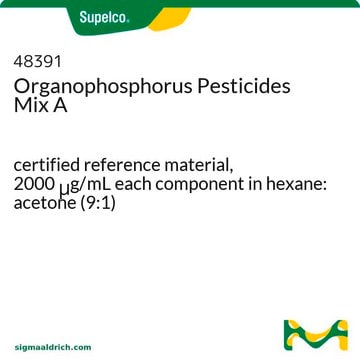추천 제품
Grade
certified reference material
Quality Level
제품 라인
TraceCERT®
grade
TraceCERT®
유통기한
limited shelf life, expiry date on the label
형식
neat
저장 온도
2-8°C
SMILES string
COP(=S)(OC)Oc1ccc(cc1)[N+]([O-])=O
InChI
1S/C8H10NO5PS/c1-12-15(16,13-2)14-8-5-3-7(4-6-8)9(10)11/h3-6H,1-2H3
InChI key
RLBIQVVOMOPOHC-UHFFFAOYSA-N
유사한 제품을 찾으십니까? 방문 제품 비교 안내
일반 설명
This certified reference material (CRM) is produced and certified in accordance with ISO/IEC 17025 and ISO 17034 . This CRM is traceable to primary material from an NMI, e.g. NIST or NMIJ.
Certified content by quantitative NMR incl. uncertainty and expiry date are given on the certificate.
Download your certificate at: http://www.sigma-aldrich.com.
Parathion methyl is a non-systemic organophosphate insecticide and acaricide. It acts by inhibiting the activity of the acetylcholinesterase (AChE) enzyme, thereby blocking hydrolysis of acetylcholine and leading to hyperexcitation. It is used to control chewing and sucking insects in cereals, fruit, citrus, vines, vegetables, ornamentals, cotton, and field crops.
According to the Commission Implementing Regulation (EU) No 2003/166/EC of 10th March 2003, parathion methyl is not approved for use in the European Union (EU) as a plant protection agent, following the Regulation (EC) No. 1107/2009. But maximum residue levels of 0.01 mg/kg to 5 mg/kg are allowed for the presence of parathion methyl (sum of parathion-methyl and paraoxon-methyl expressed as parathion-methyl) in products of plant and animal origin, according to the EU Reg. No 899/2012.
Parathion methyl has to be monitored in the Multiannual Control Programme for Pesticides Residues (MACP), run within the EU and EFTA in/on products of plant origin.
Certified content by quantitative NMR incl. uncertainty and expiry date are given on the certificate.
Download your certificate at: http://www.sigma-aldrich.com.
Parathion methyl is a non-systemic organophosphate insecticide and acaricide. It acts by inhibiting the activity of the acetylcholinesterase (AChE) enzyme, thereby blocking hydrolysis of acetylcholine and leading to hyperexcitation. It is used to control chewing and sucking insects in cereals, fruit, citrus, vines, vegetables, ornamentals, cotton, and field crops.
According to the Commission Implementing Regulation (EU) No 2003/166/EC of 10th March 2003, parathion methyl is not approved for use in the European Union (EU) as a plant protection agent, following the Regulation (EC) No. 1107/2009. But maximum residue levels of 0.01 mg/kg to 5 mg/kg are allowed for the presence of parathion methyl (sum of parathion-methyl and paraoxon-methyl expressed as parathion-methyl) in products of plant and animal origin, according to the EU Reg. No 899/2012.
Parathion methyl has to be monitored in the Multiannual Control Programme for Pesticides Residues (MACP), run within the EU and EFTA in/on products of plant origin.
애플리케이션
The certified reference material (CRM) is intended to be used as a calibrant for chromatography and other analytical techniques.
Parathion methyl CRM may also be used as given below:
Parathion methyl CRM may also be used as given below:
- Development of a fluorescence sensor based on near-infrared CuInS2 quantum dots (QDs) and organophosphorus hydrolase (OPH) to detect parathion methyl in tap water, river water, rice, and banana samples
- Evaluate polyaniline (PANI)-modified zeolite NaY as a sorbent for the extraction of multiclass pesticides from water, soil, honey, fruit, and vegetable samples and their quantification by high-performance liquid chromatography (HPLC) coupled with photodiode array (PDA) detection
- Determination of 36 pesticides in soil samples using modified QuEChERS method for extraction and dispersive-solid phase extraction (d-SPE) for clean-up, followed by quantification with liquid chromatography with tandem quadrupole linear ion trap mass spectrometry (LC-MS/MS)
- Multi-residue analysis of 160 multiclass pesticides using ethyl acetate (EtAC)/n. hexane mixture for extraction from chamomile, thyme, and marjoram samples and their analysis by gas chromatography-tandem mass spectrometry (GC-MS/MS)
- Optimization of a gas chromatography-flame photometry detector (GC-FPD) based method for the determination of 44 organophosphorous pesticide (OPP) residues in Pogostemon cablin and related product samples
- Simultaneous residue analysis of 379 pesticides in human serum samples using QuEChERS extraction method and liquid chromatography-tandem mass spectrometry (LC-MS/MS)
법적 정보
TraceCERT is a registered trademark of Merck KGaA, Darmstadt, Germany
신호어
Danger
유해 및 위험 성명서
Hazard Classifications
Acute Tox. 2 Inhalation - Acute Tox. 2 Oral - Acute Tox. 3 Dermal - Aquatic Acute 1 - Aquatic Chronic 1 - Flam. Liq. 3 - STOT RE 2
Storage Class Code
3 - Flammable liquids
WGK
WGK 3
Flash Point (°F)
114.8 °F - open cup
Flash Point (°C)
46 °C - open cup
가장 최신 버전 중 하나를 선택하세요:
자사의 과학자팀은 생명 과학, 재료 과학, 화학 합성, 크로마토그래피, 분석 및 기타 많은 영역을 포함한 모든 과학 분야에 경험이 있습니다..
고객지원팀으로 연락바랍니다.








